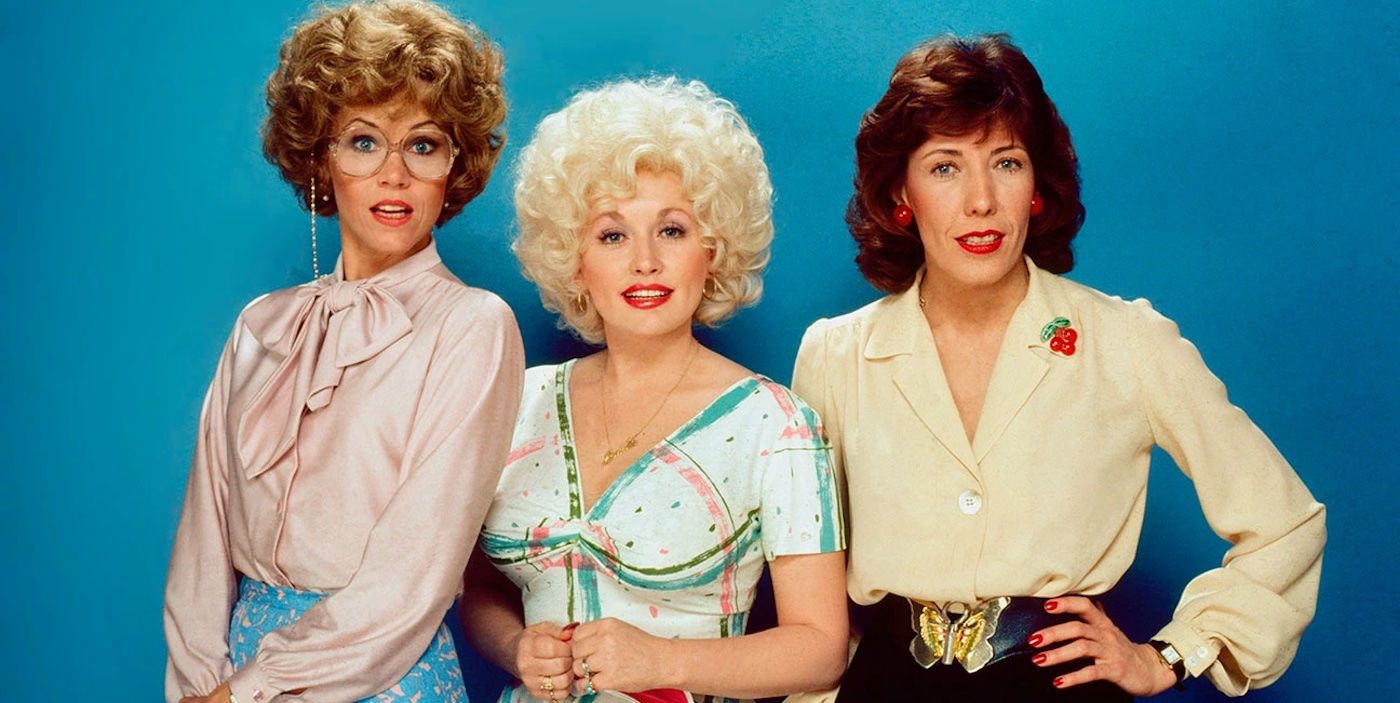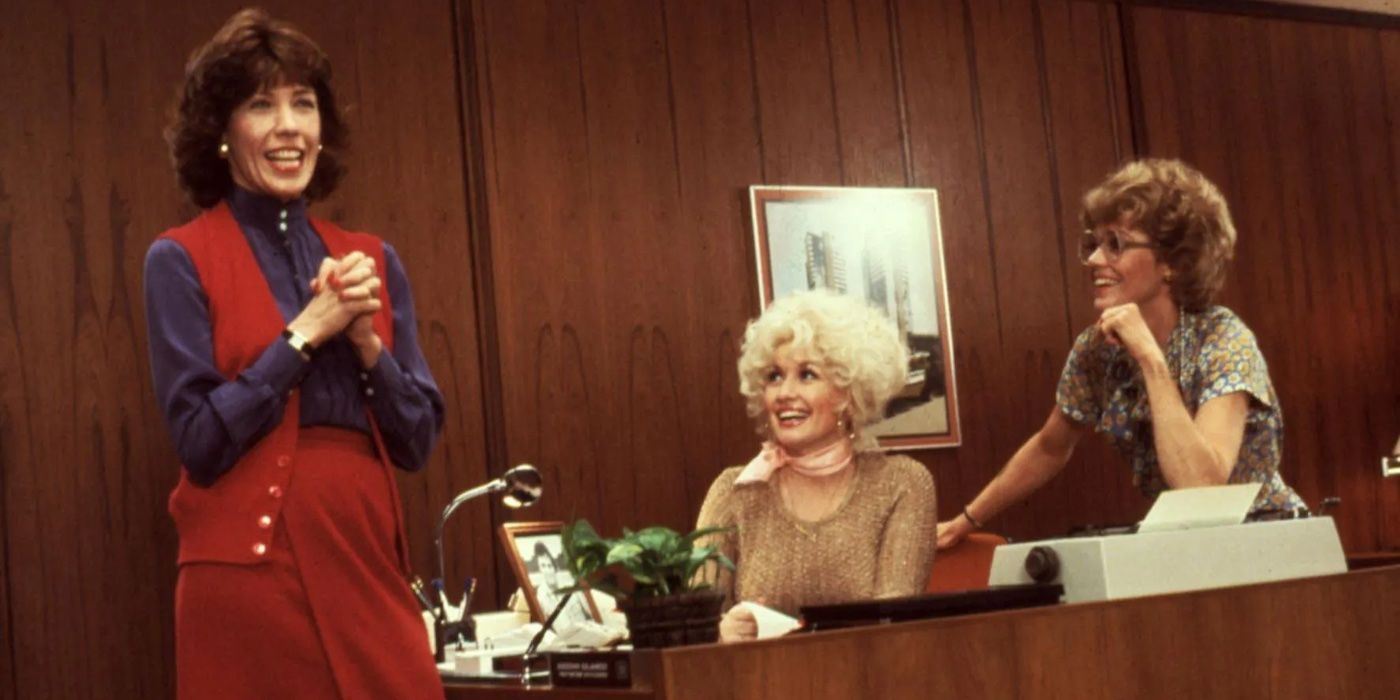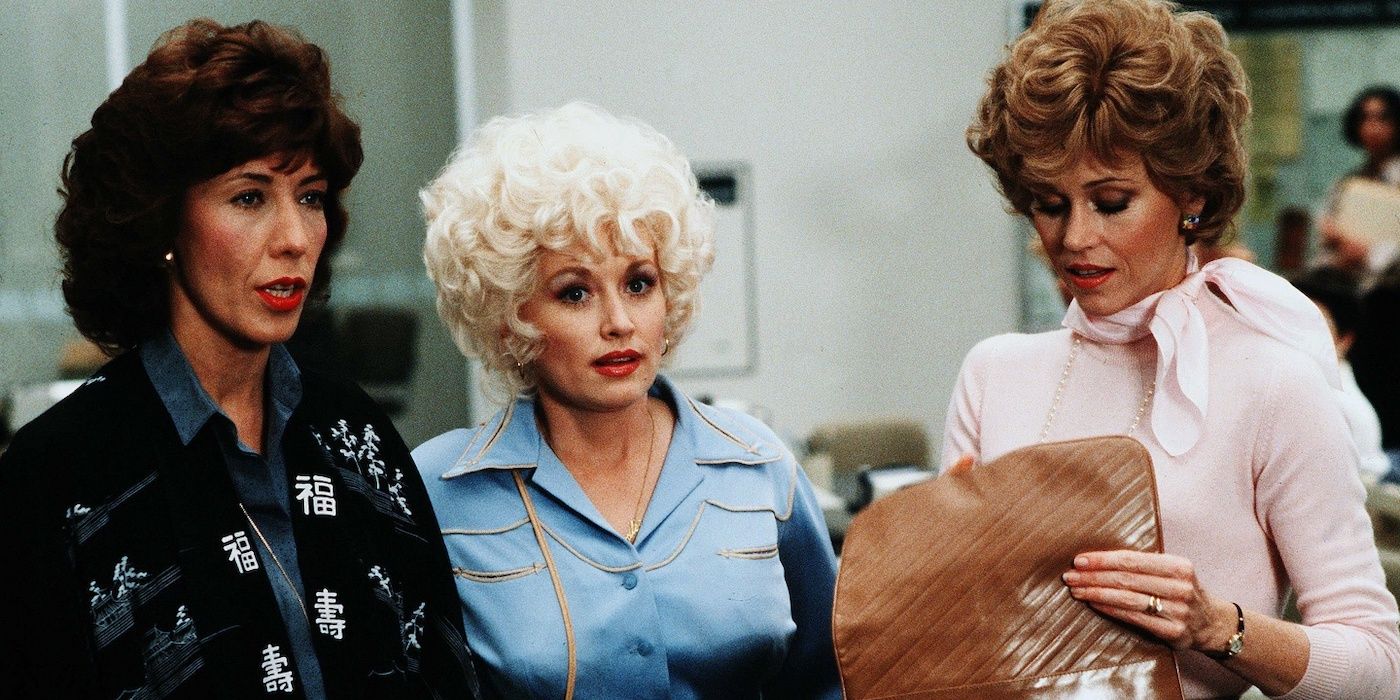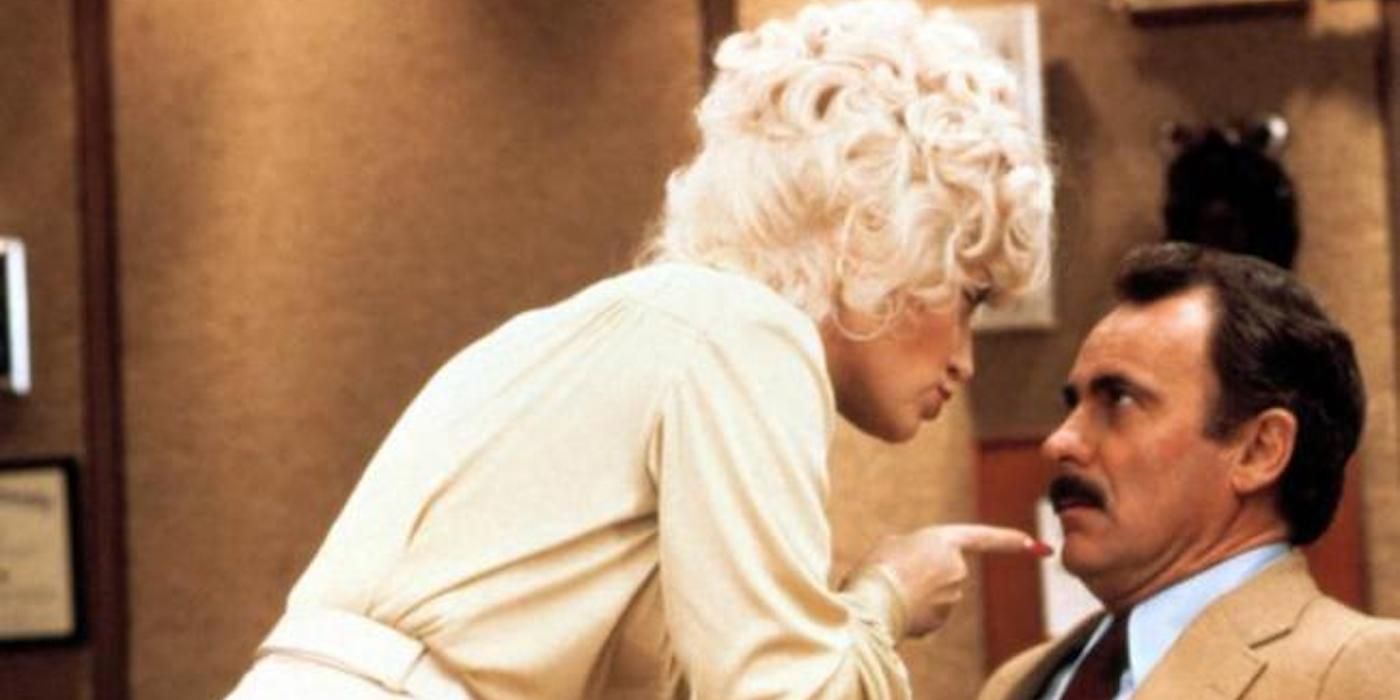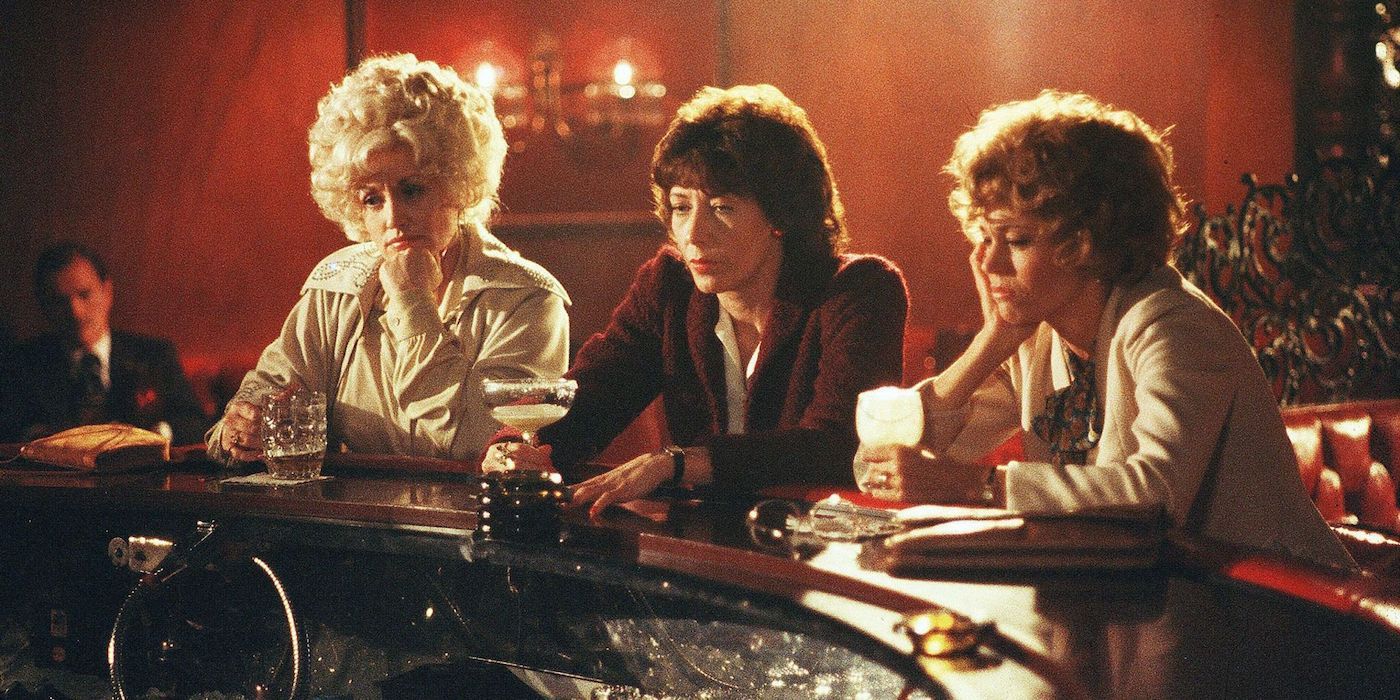"Violet, honey, would you come back here for a second?" When Doralee Rhodes (Dolly Parton) popped open the trunk of Violet Newstead's (Lily Tomlin) car and saw the dead body of their boss, Franklin Hart (Dabney Coleman), Dolly's deadpan delivery of this line sent moviegoers into hysterical laughter. 9 to 5, one of the funniest workplace comedies ever made, was the second highest-grossing film of 1980, coming in just behind Star Wars: Episode V - The Empire Strikes Back. How could a seemingly innocuous movie about three downtrodden office workers caught up in a colossal comedy of errors become such a phenomenon? It certainly didn't hurt that it starred the extraordinary Tomlin, not to mention Jane Fonda in an unexpected comic turn following her 1979 Oscar-nominated dramatic performance in The China Syndrome.
Then there's Dolly. One of America's most popular and beloved country singers was making her big screen debut as the ample-busted secretary being chased around the desk by her wolf-like superior and audiences couldn't wait to see how she would fare as an actress. There was an overpowering current of comedic electricity running between the film's female leads, and moviegoers could feel a genuine camaraderie among the women that made the entire 9 to 5 experience feel real. But beyond that, as hilarious as these ladies were together, it was the film's themes and messages that resonated with audiences. Everyone - women especially - who watched Violet, Judy Bernly (Fonda), and Doralee get the better of their buffoonish boss could identify with their plight and be only too happy to see their own revenge fantasies played out for them on the movie screen. And what's even more remarkable is that 42 years since its release, the film still holds up as a deeply cutting comment on the depressive drudgery of corporate America.
A Black Comedy Disguised as a Lighthearted Romp
Although promoted upon its release as a screwball comedy, 9 to 5 is actually a sly and smart black comedy that takes aim squarely at the corporate environment and the marginalization of the women in it, and that's one of the reasons the movie remains relevant today. Writer-director Colin Higgins was a master at crafting intricate, adventure-filled stories that also contained strong undercurrents of social commentary. Higgins penned the script for 1971's Harold and Maude, an uproariously funny film about a romance between a 79-year-old woman and a 20-year-old man. At its heart, though, the film was really a sobering meditation on the sidelined oddballs among us and the inevitability of death.
His 1978 comedy-thriller, Foul Play, was a Hitchcockian adventure that also satirized organized religion, with a plot that involved a terrorist group's attempt to assassinate the Pope and make a statement about the Catholic Church as a profit-making machine. And In 9 to 5, Higgins ingeniously packaged a story about the soullessness of the American workforce within the guise of a lighthearted romp. From the beginning, as Parton sings the film's toe-tapping theme, "They let you dream, just watch 'em shatter. You're just a step on the boss man's ladder...," a montage of harried workers on crowded city streets running for buses, spilling coffee, and dropping papers unfolds. There isn't a person on the planet who can't identify with the madness of the workaday grind, and before the opening credits have even finished rolling, audiences are all in.
Characters Every Office Worker Recognizes
When Violet first shows Judy, the new hire, the "front lines" of Consolidated, Inc., it's a dull tableau in various shades of gray filled with expressionless workers who seem to be wandering aimlessly like extras from the Walking Dead. Even though the scene is filled with office relics of days gone by, like typewriters, dictaphones, adding machines, and telephones with cords, the overall dour atmosphere is as palpable today as it was in 1980. Clearly, Consolidated is a place where people have to go, but don't want to. Then there are the employees. Higgins gives us a gaggle of supporting characters that everyone who's ever worked an office job will immediately recognize, starting with Roz (the criminally underrated Elizabeth Wilson), Mr. Hart's administrative assistant, an overpaid busybody with no discernible purpose or function other than to spy on the worker bees and compose correspondence no one reads.
When Roz hands Violet her latest memo masterpiece, Violet's response is swift and telling. "Thanks, Roz, I know just where to stick it." People like Roz were running wild through corporate hallways 42 years ago, and they continue to stalk the corridors today. The only difference now is that they annoy their colleagues with e-mails instead of mimeographs. There's Margaret (Peggy Pope), the boozy desk toiler who always looks exhausted, regardless of the time of day. She's that co-worker who's been with the company for decades in the same job and who probably hasn't had a good day since she first walked through the door. Consolidated Vice President Hart is the living embodiment of the term "suit filler," a good ol' boy with little substance who speaks in buzzwords and who's so sincere in his insincerity, he's able to dazzle the C-Suite when it counts.
While initiating Judy into the company, his eye-rolling speech is familiar to anyone who's ever worked for a manager whose primary talent is the ability to spew motivational poster-type jargon. "You girls, of course, never got a chance to play football or baseball, and I've always felt like that's unfortunate because I think it's probably the best place to learn what teamwork is all about." These types of employees are still alive and unwell in every office today, and while Higgins paints these characters with broad comic brush strokes, they're actually painfully familiar representations of corporate misery.
Making Fantasies of Killing the Boss Funny
9 to 5's primary focus is on the struggle of women in the workplace to establish equal footing with their male counterparts in terms of both pay and position. While there are more women in management today than in 1980, men still hold 62% of all management positions in corporate America, and while pay gaps between men and women have narrowed over the last 42 years, sadly, women still earn about 30% less than their male colleagues. Violet, the lead supervisor of her floor, has been passed over for promotions time and again, and when the latest position she's been vying for goes to a man, her outrage is understandable and identifiable. "I lose a promotion because of some idiot prejudice. The boys in the club are threatened, and you're so intimidated by any woman who won't sit in the back of the bus."
Doralee, the unfortunate recipient of vicious gossip about an affair with Mr. Hart, can't seem to free herself from the stereotype of the attractive young secretary who only has her job because of how she looks. When Mr. Hart's shenanigans push the women to their breaking points, Violet, Doralee, and Judy envision the violent ways in which they would murder the man who's been tormenting them. Their fantasy sequences are some of the funniest moments in the film, but in typical Higgins fashion, they also shine an uncomfortable light on the darkness of the workplace, not to mention the human soul. Judy imagines hunting Hart down, shooting him, and mounting his head on the wall. Violet, in a hilariously macabre Disney-esque scene that she describes as "something gruesome and horrible and real gory, but kinda cute," envisions herself as Snow White poisoning Hart and catapulting him out the window to the pavement below. Doralee, intent on letting Hart know what sexual harassment feels like, hog-ties Mr. Hart and spit-roasts him over an open flame.
Revenge Fantasies Become Reality
Lest things get too grim, Higgins turns the proceedings around and takes audiences on a new journey in which Violet is mistakenly led to believe she truly has poisoned Mr. Hart by accidentally putting rat poison in his coffee instead of sweetener. "It looks just like 'Skinny 'N Sweet,' except for the little skull and crossbones on the label," Judy says in an attempt to rationalize what Violet may have done. What ensues is a throwback to the screwball comedies of the 1930s and 40s that involves Violet thinking she's killed Hart and, in a panic over being found guilty of murder, stealing the wrong body from the hospital to conceal the evidence. Even amidst the clownish cacophony, Higgins still manages to slip in some sharp commentary on the cruelty of the workplace and issues of social class and standing.
When Violet thinks she's killed Hart, her first thought is about the prospect of unemployment, not incarceration. "I'm no fool. I've killed the boss. You think they're not gonna fire me for a thing like that?" she laments to Judy and Doralee. Then, when Violet attempts to smuggle a dead body on a gurney out of the hospital, she runs into a candy striper nurse's aide who sees the name tag on the lab coat Violet has stolen and assumes Violet is a doctor. "I'm a doctor," Violet says, surprising even herself. "So why the hell am I talking to you? Piss off!" Finally, when the trio of body snatchers is pulled over by a motorcycle cop and Doralee tells the officer that Violet is a doctor, Violet continues to trade on the status her new faux profession affords her. "What do you think I am, a beautician?" she quips to the cop before hitting the gas pedal and speeding off.
Redemption and Hope for the American Worker
As the already crazy plot gets even more cracked, the women eventually restrain Hart in his bedroom in a quasi-BDSM getup attached to a garage door opener while they await delivery of documents that will implicate him in an embezzlement scheme. The mere sight of Hart in chains is a not-so-subtle metaphor for what Violet, Judy, and Doralee have been enduring at Consolidated - the shackling and restriction of the American worker. That the company can continue operating without Hart at the helm is even further mockery of the ineffectiveness of executive leaders. The women take over at Consolidated and start doing what Hart never did - managing. They implement changes like equal pay policies, job-sharing, and alcohol rehabilitation programs (there's hope for Margaret yet!).
They transform the appearance of their workplace, the gray tones replaced by vibrant shades of orange and red. There's also a glimpse of a disabled worker joining the ranks! And for the pièce de résistance, the forward-thinking ladies open an onsite daycare center for employees with small children. It's at this point that 9 to 5 becomes a film about aspirations - how a transformed workplace that puts its employees ahead of profits can actually be good for business. It's not all rose-colored glasses, though. When Consolidated's Chairman of the Board, Mr. Tinsworthy (Sterling Hayden), makes a surprise visit to the floor to praise all the positive changes, he puts the kibosh on women getting the same salaries as men, telling Hart, "That equal pay thing, that's got to go. It's okay as an incentive, but we don't need to keep on primin' the pump." Even in this new utopian environment, women still can't get everything they deserve, and once again, Higgins smears those rose-colored glasses he's just handed out.
Despite the equal pay setback, 9 to 5 ends on a high note, with the three heroines succeeding in vanquishing Franklin Hart and Violet finally getting promoted in recognition of her ability to remain calm during a crisis. The three women even vow to continue the fight for equal pay for equal work. So, even though the film is an examination of the hopeless slog of that eight-hour workday, it offers the promise that change is possible, and that's why the film continues to resonate today, even if those IBM Selectrics have been replaced by Dell desktop computers.

